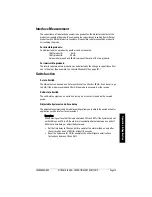
Page 22
SITRANS LC500 – OPERATING INSTRUCTIONS
7ML19985GE04
Inst
a
llat
io
n
Handling Electrodes
Mounting Instructions
The SITRANS LC500 is easily installed: simply mount the instrument on the process
connection of the vessel.
Protection for solid-state switch
•
for dc circuits: connect protection diodes in the correct polarity across the relay coil
•
for ac circuits: connect a Voltage Dependent Resistor (VDR) or other ac compatible
component (such as zeners and protection diodes in combination) in the correct
polarity across the relay coil
WARNINGS:
• Do not scratch or gouge the PFA electrode insulation since this could
reduce the integrity of the insulation and the useful life of the
electrode.
• Be careful with an enamel-insulated electrode
1
.
• Do not damage the insulation jacket on the electrode during shipping,
packing, and installation
2
. Any damage to the electrode can prevent
proper performance.
• (ATEX 95): Precautions MUST be taken to avoid ignition due to
hazardous electrostatic discharges:
a. Where an isolated probe is used in gas, vapor, or a non-
conductive liquid that is potentially explosive, requiring
apparatus group IIC equipment.
b. Where the probe is used in a potentially explosive dusty
atmosphere.
1.
Normally the enamel insulation is protected by a stilling well, which is part of
the design.
2.
Most electrodes use PFA insulation, a very dense and reliable type of Teflon®
that prevents leakage and corrosion of the metal electrode and acts as an
insulator when conductive materials are being measured.
Notes:
•
The transmitter is specified for use at temperatures ranging from –40
C to
85
C (–40
o
F to 185
o
F): if your process temperature is outside this range, a
standard option is available with a thermal isolator.
•
Before mounting the SITRANS LC500, check to ensure the threads are
matching to avoid damaging them.
















































